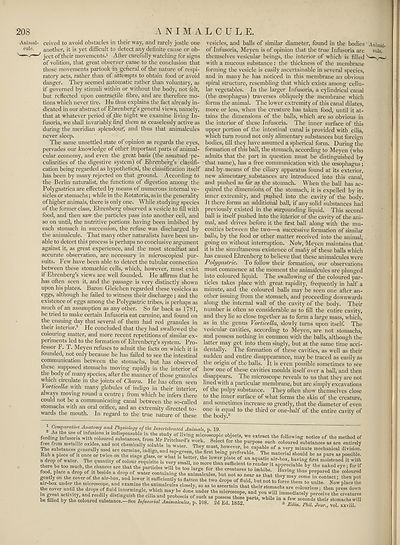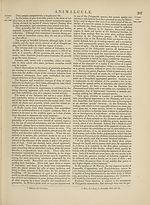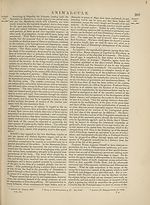Encyclopaedia Britannica > Volume 3, Anatomy-Astronomy
(216) Page 208
Download files
Complete book:
Individual page:
Thumbnail gallery: Grid view | List view

208
ANIMALCULE.
Animal¬
cule.
ceived to avoid obstacles in their way, and rarely jostle one
another, it is yet difficult to detect any definite cause or ob¬
ject of their movements.'1 After carefully watching for signs
of volition, that great observer came to the conclusion that
those movements partook in general of the nature of respi¬
ratory acts, rather than of attempts to obtain food or avoid
danger. They seemed automatic rather than voluntary, as
if governed by stimuli within or without the body, not felt,
but reflected upon contractile fibre, and are therefore mo¬
tions which never tire. He thus explains the fact already in¬
dicated in our abstract of Ehrenberg’s general views, namely,
that at whatever period of the night we examine living In¬
fusoria, we shall invariably find them as ceaselessly active as
during the meridian splendour; and thus that animalcules
never sleep.
The same unsettled state of opinion as regards the eyes,
pervades our knowledge of other important parts of animal-
cular economy, and even the great basis (the assumed pe¬
culiarities of the digestive system) of Ehrenberg’s classifi¬
cation being regarded as hypothetical, the classification itself
has been by many rejected on that ground. According to
the Berlin naturalist, the functions of digestion among the
Polygastrica are effected by means of numerous internal ve¬
sicles or stomachs; while in the Rotatoria, as in the generality
of higher animals, there is only one. While studying species
of the former class, Ehrenberg observed a vesicle to fill with
food, and then saw the particles pass into another cell, and
so on until, the nutritive portions having been imbibed by
each stomach in succession, the refuse was discharged by
the animalcule. That many other naturalists have been un¬
able to detect this process is perhaps no conclusive argument
against it, as great experience, and the most steadfast and
accurate observation, are necessary in microscopical pur¬
suits. Few have been able to detect the tubular connection
between these stomachic cells, which, however, must exist
if Ehrenberg’s views are well founded. He affirms that he
has often seen it, and the passage is very distinctly shown
upon his plates. Baron Gleichen regarded these vesicles as
eggs, although he failed to witness their discharge ; and the
existence of eggs among the Polygastric tribes, is perhaps as
much of an assumption as any other. So far back as 1781,
he tried to make certain Infusoria eat carmine, and found on
the ensuing day that several of them had red granules in
their interior.2 He concluded that they had swallowed the
colouring matter, and more recent repetitions of similar ex¬
periments led to the formation of Ehrenberg’s system. Pro¬
fessor F. T. Meyen refuses to admit the facts on which it is
founded, not only because he has failed to see the intestinal
communication between the stomachs, but has observed
these supposed stomachs moving rapidly in the interior of
the body of many species, after the manner of those granules
which circulate in the joints of CIicltcl. He has often seen
VorticellcB with many globules of indigo in their interior,
always moving round a centre; from which he infers there
could not be a communicating canal between the so-called
stomachs with an oral orifice, and an extremity directed to¬
wards the mouth. In regard to the true nature of these
vesicles, and balls of similar diameter, found in the bodies' Animal-
of Infusoria, Meyen is of opinion that the true Infusoria are cuie.
themselves vesicular beings, the interior of which is filled
with a mucous substance: the thickness of the membrane
forming the vesicle is easily ascertainable in several species,
and in many he has noticed in this membrane an obvious
spiral structure, resembling that which exists among cellu¬
lar vegetables. In the larger Infusoria, a cylindrical canal
(the oesophagus) traverses obliquely the membrane which
forms the animal. The lower extremity of this canal dilates,
more or less, when the creature has taken food, until it at¬
tains the dimensions of the balls, which are so obvious in
the interior of these Infusoria. The inner surface of this
upper portion of the intestinal canal is provided with cilia,
which turn round not only alimentary substances but foreign
bodies, till they have assumed a spherical form. During the
formation of this ball, the stomach, according to Meyen (who
admits that the part in question must be distinguished by
that name), has a free communication with the oesophagus ;
and by-means of the ciliary apparatus found at its exterior,
new alimentary.substances are introduced into this canal,
and pushed as far as the stomach. When the ball has ac¬
quired the dimensiohs of the stomach, it is expelled by its
inner extremity, and pushed into the cavity of the body.
It there forms an additional ball, if any solid substances had
previously existed in the surrounding liquid. This second
ball is itself pushed into the interior of the cavity of the ani¬
mal, and drives before it the first ball along with the mu-
cosities between the two—a successive formation of similar
balls, by the food or other matter received into the animal, .
going on without interruption. Now, Meyen maintains that
it is the simultaneous existence of many of these balls which
has caused Ehrenberg to believe that these animalcules were
Polygastric. To follow their formation, our observations
must commence at the moment the animalcules are plunged
into coloured liquid. I he swallowing of the coloured par¬
ticles takes place with great rapidity, frequently in half a
minute, and the coloured balls may be seen one after an¬
other issuing from the stomach, and proceeding downwards
along the internal wall of the cavity of the body. Their
number is often so considerable as to fill the entire cavity,
and they lie so close together as to form a large mass, which,
as in the genus Vorticella, slowly turns upon itself. The
vesicular cavities, according to Meyen, are not stomachs,
and possess nothing in common with the balls, although the
latter may get into them singly, but at the same time acci¬
dentally. The formation of these cavities, as well as their
sudden and entire disappearance, may be traced as easily as
the origin of the balls. It is even possible sometimes to see
how one of these cavities moulds itself over a ball, and then
disappears. I he microscope reveals to us that they are not
lined with a particular membrane, but are simply excavations
of the pidpy substance. They often show themselves close
to the inner surface of what forms the skin of the creature,
and sometimes increase so greatly, that the diameter of even
one is equal to the third or one-half of the entire cavity of
the body.3
I Comparative Anatomy and Physiology of the Invertehrated Animals, p. 19.
feeding fnfusoria^with^olmii^ed'fubstances^from'Mi^Piltchard’rwork"^^Select^br^the ^ eXtraCt f°ll0Wing n°tiCe °f the meth°d °f
free from metallic oxides, and not chemically soluble in water They* must however h^Ar^ Coloured substanccs as are entirely
The substances generally used are carmine, indigo, and sap-gre'en ihefirst beiAprArable The m t ^7 uAA mechanical divisi«n-
Rub a piece of it once or twice on the stage glass, or what is better the lower nlL of nn A material should be as pure as possible,
a drop of water. The quantity of colour requisite is verv small no more th-mLffir- + t quatic air-box, having first moistened it with
there be too much, the chances are that the particles wil/be too’large for the creatures tAA 7 ^ aj)Pr®clable by the naked eye; for if
food, place a drop of it beside a drop of waL contaSg ^ ^ ^
gently on the cover of the air-box, and lower it sufficiently to flatten the two drons of fluid but n 7 7 COme m contactl then Put
air-box under the microscope, and examine the animalcules clLelTso as rateTtain that ’their sto Z™ A N°W PlaC6 the
the cover until the drops of fluid intermingle, which may be doneAnder the microscope aid vou^lTimm^lA7 * 5 then H688 down
in great activity, and readily distinguish the cilia and proboscis of such as possess tho^e’par^whUe iAT 7 Percueiye the creatUr7
be filled by the coloured substance.—See Infusorial Animalcules, p. 108. Id Ed 1852 P ’ 3 SJ' stomach8.wl11
ANIMALCULE.
Animal¬
cule.
ceived to avoid obstacles in their way, and rarely jostle one
another, it is yet difficult to detect any definite cause or ob¬
ject of their movements.'1 After carefully watching for signs
of volition, that great observer came to the conclusion that
those movements partook in general of the nature of respi¬
ratory acts, rather than of attempts to obtain food or avoid
danger. They seemed automatic rather than voluntary, as
if governed by stimuli within or without the body, not felt,
but reflected upon contractile fibre, and are therefore mo¬
tions which never tire. He thus explains the fact already in¬
dicated in our abstract of Ehrenberg’s general views, namely,
that at whatever period of the night we examine living In¬
fusoria, we shall invariably find them as ceaselessly active as
during the meridian splendour; and thus that animalcules
never sleep.
The same unsettled state of opinion as regards the eyes,
pervades our knowledge of other important parts of animal-
cular economy, and even the great basis (the assumed pe¬
culiarities of the digestive system) of Ehrenberg’s classifi¬
cation being regarded as hypothetical, the classification itself
has been by many rejected on that ground. According to
the Berlin naturalist, the functions of digestion among the
Polygastrica are effected by means of numerous internal ve¬
sicles or stomachs; while in the Rotatoria, as in the generality
of higher animals, there is only one. While studying species
of the former class, Ehrenberg observed a vesicle to fill with
food, and then saw the particles pass into another cell, and
so on until, the nutritive portions having been imbibed by
each stomach in succession, the refuse was discharged by
the animalcule. That many other naturalists have been un¬
able to detect this process is perhaps no conclusive argument
against it, as great experience, and the most steadfast and
accurate observation, are necessary in microscopical pur¬
suits. Few have been able to detect the tubular connection
between these stomachic cells, which, however, must exist
if Ehrenberg’s views are well founded. He affirms that he
has often seen it, and the passage is very distinctly shown
upon his plates. Baron Gleichen regarded these vesicles as
eggs, although he failed to witness their discharge ; and the
existence of eggs among the Polygastric tribes, is perhaps as
much of an assumption as any other. So far back as 1781,
he tried to make certain Infusoria eat carmine, and found on
the ensuing day that several of them had red granules in
their interior.2 He concluded that they had swallowed the
colouring matter, and more recent repetitions of similar ex¬
periments led to the formation of Ehrenberg’s system. Pro¬
fessor F. T. Meyen refuses to admit the facts on which it is
founded, not only because he has failed to see the intestinal
communication between the stomachs, but has observed
these supposed stomachs moving rapidly in the interior of
the body of many species, after the manner of those granules
which circulate in the joints of CIicltcl. He has often seen
VorticellcB with many globules of indigo in their interior,
always moving round a centre; from which he infers there
could not be a communicating canal between the so-called
stomachs with an oral orifice, and an extremity directed to¬
wards the mouth. In regard to the true nature of these
vesicles, and balls of similar diameter, found in the bodies' Animal-
of Infusoria, Meyen is of opinion that the true Infusoria are cuie.
themselves vesicular beings, the interior of which is filled
with a mucous substance: the thickness of the membrane
forming the vesicle is easily ascertainable in several species,
and in many he has noticed in this membrane an obvious
spiral structure, resembling that which exists among cellu¬
lar vegetables. In the larger Infusoria, a cylindrical canal
(the oesophagus) traverses obliquely the membrane which
forms the animal. The lower extremity of this canal dilates,
more or less, when the creature has taken food, until it at¬
tains the dimensions of the balls, which are so obvious in
the interior of these Infusoria. The inner surface of this
upper portion of the intestinal canal is provided with cilia,
which turn round not only alimentary substances but foreign
bodies, till they have assumed a spherical form. During the
formation of this ball, the stomach, according to Meyen (who
admits that the part in question must be distinguished by
that name), has a free communication with the oesophagus ;
and by-means of the ciliary apparatus found at its exterior,
new alimentary.substances are introduced into this canal,
and pushed as far as the stomach. When the ball has ac¬
quired the dimensiohs of the stomach, it is expelled by its
inner extremity, and pushed into the cavity of the body.
It there forms an additional ball, if any solid substances had
previously existed in the surrounding liquid. This second
ball is itself pushed into the interior of the cavity of the ani¬
mal, and drives before it the first ball along with the mu-
cosities between the two—a successive formation of similar
balls, by the food or other matter received into the animal, .
going on without interruption. Now, Meyen maintains that
it is the simultaneous existence of many of these balls which
has caused Ehrenberg to believe that these animalcules were
Polygastric. To follow their formation, our observations
must commence at the moment the animalcules are plunged
into coloured liquid. I he swallowing of the coloured par¬
ticles takes place with great rapidity, frequently in half a
minute, and the coloured balls may be seen one after an¬
other issuing from the stomach, and proceeding downwards
along the internal wall of the cavity of the body. Their
number is often so considerable as to fill the entire cavity,
and they lie so close together as to form a large mass, which,
as in the genus Vorticella, slowly turns upon itself. The
vesicular cavities, according to Meyen, are not stomachs,
and possess nothing in common with the balls, although the
latter may get into them singly, but at the same time acci¬
dentally. The formation of these cavities, as well as their
sudden and entire disappearance, may be traced as easily as
the origin of the balls. It is even possible sometimes to see
how one of these cavities moulds itself over a ball, and then
disappears. I he microscope reveals to us that they are not
lined with a particular membrane, but are simply excavations
of the pidpy substance. They often show themselves close
to the inner surface of what forms the skin of the creature,
and sometimes increase so greatly, that the diameter of even
one is equal to the third or one-half of the entire cavity of
the body.3
I Comparative Anatomy and Physiology of the Invertehrated Animals, p. 19.
feeding fnfusoria^with^olmii^ed'fubstances^from'Mi^Piltchard’rwork"^^Select^br^the ^ eXtraCt f°ll0Wing n°tiCe °f the meth°d °f
free from metallic oxides, and not chemically soluble in water They* must however h^Ar^ Coloured substanccs as are entirely
The substances generally used are carmine, indigo, and sap-gre'en ihefirst beiAprArable The m t ^7 uAA mechanical divisi«n-
Rub a piece of it once or twice on the stage glass, or what is better the lower nlL of nn A material should be as pure as possible,
a drop of water. The quantity of colour requisite is verv small no more th-mLffir- + t quatic air-box, having first moistened it with
there be too much, the chances are that the particles wil/be too’large for the creatures tAA 7 ^ aj)Pr®clable by the naked eye; for if
food, place a drop of it beside a drop of waL contaSg ^ ^ ^
gently on the cover of the air-box, and lower it sufficiently to flatten the two drons of fluid but n 7 7 COme m contactl then Put
air-box under the microscope, and examine the animalcules clLelTso as rateTtain that ’their sto Z™ A N°W PlaC6 the
the cover until the drops of fluid intermingle, which may be doneAnder the microscope aid vou^lTimm^lA7 * 5 then H688 down
in great activity, and readily distinguish the cilia and proboscis of such as possess tho^e’par^whUe iAT 7 Percueiye the creatUr7
be filled by the coloured substance.—See Infusorial Animalcules, p. 108. Id Ed 1852 P ’ 3 SJ' stomach8.wl11
Set display mode to:
![]() Universal Viewer |
Universal Viewer | ![]() Mirador |
Large image | Transcription
Mirador |
Large image | Transcription
Images and transcriptions on this page, including medium image downloads, may be used under the Creative Commons Attribution 4.0 International Licence unless otherwise stated. ![]()
| Encyclopaedia Britannica > Encyclopaedia Britannica > Volume 3, Anatomy-Astronomy > (216) Page 208 |
|---|
| Permanent URL | https://digital.nls.uk/193760156 |
|---|
| Attribution and copyright: |
|
|---|---|
| Shelfmark | EB.16 |
|---|---|
| Description | Ten editions of 'Encyclopaedia Britannica', issued from 1768-1903, in 231 volumes. Originally issued in 100 weekly parts (3 volumes) between 1768 and 1771 by publishers: Colin Macfarquhar and Andrew Bell (Edinburgh); editor: William Smellie: engraver: Andrew Bell. Expanded editions in the 19th century featured more volumes and contributions from leading experts in their fields. Managed and published in Edinburgh up to the 9th edition (25 volumes, from 1875-1889); the 10th edition (1902-1903) re-issued the 9th edition, with 11 supplementary volumes. |
|---|---|
| Additional NLS resources: |
|

